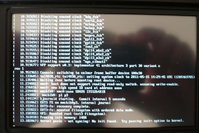Hi Dave,
cant thank you enough for this app. I find it brilliant and was looking forward to testing out your opkg installer for the dev tools and other things. However I keep getting wiped out at the moment, without the chance to make the alterations to the autoboot.txt file, or the file checking options, as the OS partition is simply getting deleted.
One thing I have noticed when using the SD Installer is that the latest revision has definitely made sure the SWAP partition is created of the approx size requested (sector size or whatever allowing) but I find that the estimate made for the EXT2 partition from the remaining size left from the FAT32, is wildly out.
I had to re-do the process several times initially (increasing the EXT2 space by decreasing the FAT32 space) until I actually get an PANDORAROOT partition that is as big as I needed i.e Filesystem, plus enough space for DEV stuff and plenty spare for other opkg installs.
So on a 32gb card I needed to allocate about 5gb spare to the EXT2 area + 512mb for SWAP in order to actually get a 3.4gb partition for the OS. Bigger than wanted but if I go any smaller than that, I find the OS partition has only about 600mb spare space, rather than what was estimated.
Aside from that it would be great if you could either add the option to name the partitions yourself, or have a shorter name like ROOT, BOOT, SWAP (SONY with the ladies

j/k) as if you reduce icon size to around 30 on the desktop for more space, the SD cards cant be told apart and in Thunar, the long PANDORAR or PANDORAB is about all that's visible by default. Nothing major and they could be renamed afterwards but I'd rather set them as they are made.
What I would like to ask aswell, is in relation to whats happening when the OS gets deleted.
Its time consuming to reload the BOOT partition with data (I haven't figured out CloneZilla yet) and I am wondering if there is any way to simply re-make the EXT2 ROOT partition and have the OS re-applied to just that partition? In order to avoid deleting the entire card. Would the normal steps of unpacking a tar into that partition if named PANDORAROOT work with the remaining partitions the SD Installer originally created?
Edit : I've just found its perfectly possible to use Gparted to remake the EXT2 partition and re-label it, then unpack a HFtar into it with sudo tar <tarname> /media/PANDORAROOT. I'm learning something :rolleyes: .
Now I've not made a HF5 card before and so don't have the correct autoboot.txt. Could you tell me which of the ones listed here
http://pandorawiki.org/Running_Linux_from_an_SD_card is correct please? Is it the one for multiple partitions? Or does SD Installer do anything different in order to use the SWAP file?
Sorry for the wall of text and the no doubt stupid requests and thank you again for an already great piece of utility software.


